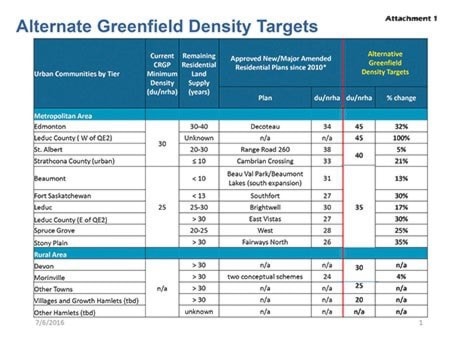What does the future of the Capital Region look like? In 20 to 30 years, is this entire region going to be an Edmonton suburb?
The Capital Region Board, which includes Edmonton and the group of municipalities surrounding it on all sides, recently approved new residential density targets that, in essence, describe how many neighbours each future resident of various areas will have in the future.
“New density targets approved by the Capital Region Board today will support the compact growth required as the Edmonton Metropolitan Region doubles in population in the next 30 years,” stated a July 14 press release from the CRB. Density rates essentially govern where growth occurs in the future because, if a certain number of people moving into the region can be calculated and combined with the number allowed per hectare, it becomes obvious how much new land is needed to make everyone happy.
The term “compact” may be relative, as Leduc County mayor John Whaley said he was actually looking for tighter density, rather than what seemed like urban municipalities pushing for looser numbers.
Did Leduc County have as much input into the population density numbers as the municipality would’ve liked? According to Whaley, “Yes and no,” he said by phone from the county office July 20.
“It’s a first step towards putting some sort of limits on it. I don’t think they’ve gone far enough. But it’s a first step.”
Whaley said he answered that way because the process seemed rushed. He noted the process hummed right along apparently because of a CRB desire to have the density numbers and other information in the Growth Plan 2.0 ready to submit to the provincial government by October while Whaley said he sees reasons to slow down. “I’d like for everyone to be on the same page,” said Whaley, suggesting “pressing the pause button” off on the plan until New Years.
“There should be a true consensus in the region before we move forward.”
Whaley noted he voted in favour of higher residential densities in future communities surrounding Edmonton, which would be new subdivisions and other developments in places like Leduc County and the City of Leduc. He added that his vote was aimed to keeping Edmonton’s south side at a 50 rate (see chart).
Whaley said he was also in favour of higher density rates for Leduc County, say 35 to 40, his reasoning being that if farmland has to be taken out of production for residential growth, then it should be at the highest possible density to prevent sprawl. This also makes infrastructure dollars go farther as the closer people and amenities are to each other, the less infrastructure needs to be built. “We’ve got to stop the sprawl,” said Whaley.
The mayor also noted the municipality of Fort Saskatchewan proposed reducing the densities by five; eight rural municipalities voted against this, but the motion passed.
Whaley made a good point by stating a finger is often pointed at rural municipalities accusing them of condemning sprawl, but employing it when convenient. “Rurals have to stop sprawl too,” said Whaley, citing examples like residential subdivisions and country residential acreages that often restrict urban ability to grow.
How do these limits affect Leduc County residents? The mayor noted grandfathering is the watchword, so these limits affect future developments, not current ones. “They will not have to conform to these new density targets,” said Whaley. He noted the new targets could take 20 to 30 years to mature.
The mayor also noted that he suspects the large urban centres like Edmonton are awakening to the issue of sprawl. “I can sense it,” he said. “I can feel it.” The mayor noted urban planning is like a train running down a track, not necessarily easy to stop or even slow down. But he feels urban centres are realizing urban sprawl’s negative effects.
CRB board chair Nolan Crouse was more ebullient about the agreement. “I am proud of what we accomplished here today,” said Crouse in a press release July 14. “We have agreed to targets for land use many years out, which, as per the CRB mandate, set the conditions for the continuing prosperity of the Region in the future.
“It’s critical to remember the effects of these changes may not be felt for at least 15- 20 years. We have plans in place for most of the land we need for the foreseeable future. These targets establish the pattern of how we know we must build going forward.”
Whaley also stated he wants the CRB to debate at their next meeting the idea of slowing down the growth plan process in order to examine input from a CRB mayor’s group, the Metro Mayors Alliance. The mayor’s group has been working with urban planning expert Brad Stelfox, who is also considered an expert on urban sprawl and Whaley said the mayors have really heard some interesting information that could benefit the growth plan
“Otherwise, we’re going to make decisions, go to the minister, think everyone is happy… they’re not,” added Whaley.
